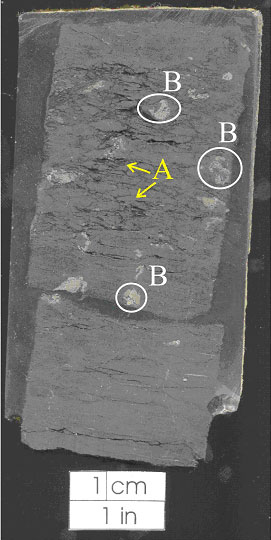 |
|
Kansas Geological Survey Open-file Report 2003-82 |
2.1.3 Pyritic Shale Facies
Description
The pyritic black shale facies consists of micaceous dark gray to black shale.
Diagnostic features include poorly developed irregular laminations (3 mm),
and abundant pyritized wood and plant fragments (Figure 2.05). Angular pyrite
concretions are approximately 0.25 inches in diameter (8 mm). Trace or body
fossils were not observed in the pyritic black shale facies. Thickness of
the pyritic shale facies ranges from 5 to 20 feet (1.5 to 6 m). Contacts with
the overlying and underlying facies are gradational.
Paleoenvironmental Interpretation
The abundance of pyrite concretions, pyritized plant material and poorly developed
laminations suggest deposition from sediment fallout in a brackish water marginal
marine environment. An abundance of pyrite nodules and associated plant fragments
appears related to swamp or marsh environments (Ho and Coleman, 1969). No
marine fossils were observed. The pyritic black shale facies is interpreted
as being deposited in a brackish water, coastal marsh or swamp environment.
Historically, the pyritic shale facies would be interpreted as part of the
“outside shale” in the cyclothem model (Heckel, 1977).
 |
| Figure 2.05 - Polished core section of the pyritic black shale facies. Note the development of irregular laminations (A) and angular pyrite concretions (B) of apporximately 0.25 inches in diameter (90 mm). The black appearance is due to a high organic content (i.e. carbonized wood fragments). Sample from 1,076' in the Hinthorn CW#1 well, 14-T32S-R16E, Montgomery County, Kansas |
e-mail : webadmin@kgs.ku.edu
Last updated December 2003
http://www.kgs.ku.edu/PRS/publication/2003/ofr2003-82/chapter2_3.html